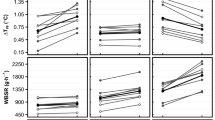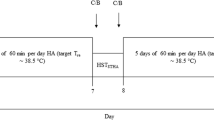Abstract
The present study was designed to determine the relative importance of individual characteristics such as maximal oxygen uptake (\(\dot V\)O2max), adiposity, DuBois body surface area (A D), surface to mass ratio (A D: mass) and body mass, for the individual's reaction to humid heat stress. For this purpose 27 subjects (19 men, 8 women), with heterogeneous characteristics (\(\dot V\)O2max 1.86–5.28 1 · min−1; fat% 8.0%–31.9%; mass 49.8–102.1 kg; A D 1.52–2.33 m2) first rested (30 min) and then exercised (60 W for 1 h) on a cycle ergometer in a warm humid climate (35°C, 80% relative humidity). Their physiological responses at the end of exercise were analysed to assess their relationship with individual characteristics using a stepwise multiple regression technique. Dependent variables (with ranges) included final values of rectal temperature (T re 37.5–39.0°C), mean skin temperature (T sk 35.7–37.5°C), body heat storage (S 3.2–8.1 J · g−1), heart rate (HR 100–172 beat · min–1), sweat loss (397–1403g), mean arterial blood pressure (BPa, 68–96 mmHg), forearm blood flow (FBF, 10.1–33.9 ml · 100ml−1 · min−1) and forearm vascular conductance (FVC = FBF/BPa, 0.11–0.49 ml · 100 ml−1 · min−1 · mmHg−1). The T re, T sk and S were (34%–65%) determined in the: main by (\(\dot V\)O2max), or by exercise intensity expressed as a percent age of \(\dot V\)O2max (%\(\dot V\)O2max). For T re, A D: mass ratio also contributed to the variance explained, with about half the effect of (\(\dot V\)O2max), For T sk, fat% contributed to the variance explained with about two-third the effect of \(\dot V\)O2max. Total body sweat loss was highly dependent (50%) on body size (A D or mass) with regular activity level having a quarter of the effect of body size on sweat loss. The HR, similar to T re, was determined by \(\dot V\)O2max (48%–51%), with less than half the effect of A D or A D :mass (20%). Other circulatory parameters (FBF, BPa, FVC) showed little relationship with individual characteristics ( < 36% of variance explained). In general, the higher the (\(\dot V\)O2max), and/or the bigger the subject, the lower the heat strain observed. The widely accepted concept, that body core temperature is determined by exercise intensity expressed as % \(\dot V\)O2max and sweat loss by absolute heat load, was only partially supported by the results. For both variables, other individual characteristics were also shown to contribute.
Similar content being viewed by others
References
Akers RF, Buskirk ER (1969) An underwater weighing system utilizing “force cube” transducers. J Appl Physiol 26:649–652
Anderson RK, Kenney WL (1987) Effect of age on heat-activated sweat gland density and flow during exercise in dry heat. J. Appl. Physiol. 63:1089–1094
Åstrand I (1960) Aerobic work capacity in men and women with special reference to age. Acta Physiol Scand 49 [Suppl 169]:1–92
Avellini BA, Kamon E (1980) Physiological responses of physically fit men and women to acclimatization to humid heat. J Appl Physiol 49:254–261
Avellini BA, Shapiro Y, Fortney SM, Wenger CB, Pandolf KB (1982) Effects on heat tolerance of physical training in water and on land. J Appl Physiol 53: 1291–1298
Burse RL (1979) Sex differences in human thermoregulatory response to heat and cold stress. Hum. Factors 21:687–699
Buskirk ER (1971) The physiological basis of rehabilitation. Saunders, Philadelphia
Drinkwater BL, Horvath SM (1979) Heat tolerance and aging. Med Sci Sports 11:49–55
DuBois D, DuBois EF (1916) Clinical calorimetry: a formula to estimate the appropriate surface area if height and weight be known. Arch Int Med 17:863–871
Durnin JVGA, Womersly J (1974) Body fat assessed from total body density and its estimation from skinfold thickness: measurements on 481 men and women aged 16 to 72 years. Br J Nutr 32:77–97
Frye AJ, Kamon E (1981) Responses to dry heat of men and women with similar aerobic capacities. J Appl Physiol 50:65–70
Frye AJ, Kamon E, Webb M (1982) Responses of menstrual women, amenorrheal women and men to exercise in a hot, dry environment. Fur J Appl Physiol 48:279–288
Gagge AP (1973) Rational temperature indices of man's thermal environment and their use with a 2-node model of his temperature regulation. Fed Proc 32:1572–1582
Givoni B, Goldman RF (1973) Predicting effects of heat acclimatization on heart rate and rectal temperature. J Appl Physiol 35:875–879
Havenith G (1985) Individual parameters in thermoregulatory control; a review. Institute for Perception, SOESTERBERG, NL Report no. IZF 1985-26
Havenith G, van Middendorp H (1990) The relative influence of physical fitness, acclimation state, anthropometric measures and gender on individual reactions to heat stress. Fur. J. Appl. Physiol. 61:419–427
Havenith G, Inoue Y, Luttikholt VGM, Kenney WL (1993) Combined effect of age and on body temperature during work in a warm, humid climate in a heterogeneous subject population. Proceedings of Thermal Physiology Symposium, IUPS, Glasgow.
Havenith G, Inoue Y, Luttikholt VGM, Kenney WL (1995) Age predicts cardiovascular, but not thermoregulatory, responses to humid heat stress. Fur J Appl Physiol 70:88–96
Haymes E, McCormick R, Buskirk E (1975) Heat tolerance of exercising lean and obese prepubertal boys. J Appl Physiol 39:457–461
Henane R, Flandrois R, Charbonnier JP (1977) Increases in sweating sensitivity by endurance conditioning in man. J Appl Physiol 43:822–828
ISO (1982) Hot environments, heat stress estimation for working humans based on WBGT. International Standard Organization, Geneva, Report no. 7243
ISO (1989) Hot environments, analytical determination and interpretation of thermal stress using calculation of required sweat rate. International Standard Organization, Geneva, Report no. 7933
Kenney WL (1985) A review of comparative responses of men and women to heat stress. Environ. Res. 37:1–11
Kenney WL (1988) Control of heat-induced vasodilation in relation to age. Fur. J Appl. Physiol. 57:120–125
Kenney WL, Havenith G (1993) Heat stress and age: skin blood flow and body temperature. J Therm Biol 18:341–344
Lotens WA (1993) Heat transfer from humans wearing clothing. Thesis, Technical University, Delft
McArdle WD, Magel JR, Gergley TG, Spina RJ, Toner MM (1984) Thermal adjustment to cold water in resting men and women. J Appl Physiol 56:1565–1571
Pandolf KB, Cadarette BS, Sawka MN, Young AJ, Francesconi RP, Gonzalez RR (1988) Thermoregulatory responses of middle-aged and young men during dry-heat acclimation. J Appl. Physiol. 65:65–71
Ross AM, Jackson AS (1990) Exercise concepts, calculations and computer applications. Benchmark Press, Carmel
Saltin B, Hermansen L (1966) Esophageal, rectal and muscle temperature during exercise. J Appl Physiol 21:1757–1762
Shapiro Y, Pandolf KB, Avellini BA, Pimental NA, Goldman RF (1980) Physiological responses of men and women to humid and dry heat. J Appl Physiol 49:1–8
Slattery ML, Jacobs DR (1987) The inter-relationships of physical activity, physical fitness, and body measurements. Med Sci Sports Exerc 19:564–569
Sobolski JC, Kolesar JJ, Kornitzer MD, De Backer GG, Mikes Z, Dramaix MM, Degre SG, Denolin HF (1988) Physical fitness does not reflect activity patterns in middle-aged workers. Med Sci Sports Exerc 20:6–13
Vroman NB, Buskirk ER, Hodgson JL (1983) Cardiac output and skin blood flow in lean and obese individuals during exercise in the heat. J Appl Physiol 55:69–74
Wenzel HG, Mehnert C, Schwarzemau P (1989) Evaluation of tolerance limits for humans under heat stress and the problems involved. Scand J Work Environ Health [Suppl. 1] 15:7–14
Whitney RJ (1953) The measurement of volume changes in human limbs. J Physiol (Lond) 121:1–27
Wilkinson L (1990) SYSTAT: the system for statistics. Systat, Evanston, Il
Author information
Authors and Affiliations
Rights and permissions
About this article
Cite this article
Havenith, G., Luttikholt, V.G.M. & Vrijkotte, T.G.M. The relative influence of body characteristics on humid heat stress response. Eur J Appl Physiol 70, 270–279 (1995). https://doi.org/10.1007/BF00238575
Accepted:
Published:
Issue Date:
DOI: https://doi.org/10.1007/BF00238575




